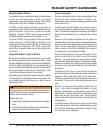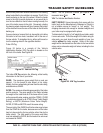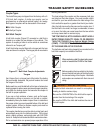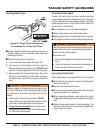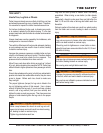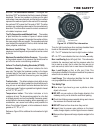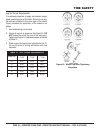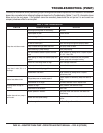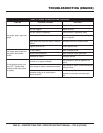
MQ62TDD TRASH PUMP • OPERATION AND PARTS MANUAL — REV. #0 (07/30/09) — PAGE 43
Studies of tire safety show that maintaining proper tire
pressure, observing tire and vehicle load limits (not carrying
more weight in your vehicle than your tires or vehicle can
safely handle), avoiding road hazards and inspecting tires
for cuts, slashes and other irregularities are the most
important things you can do to avoid tire failure, such as
tread separation or blowout and flat tires. These actions,
along with other care and maintenance activities, can also:
■
Improve vehicle handling
■
Help protect you and others from avoidable breakdowns
and accidents.
■
Improve fuel economy
■
Increase the tire life
Use the information contained in this section to make tire
safety a regular part of your vehicle maintenance routine.
Recognize that the time you spend is minimal compared
with the inconvenience and safety consequences of a flat
tire or other tire failure.
Tire Fundamentals
Federal law requires tire manufacturers to place
standardized information on the sidewall of all tires (Figure
31). This information identifies and describes the
fundamental characteristics of the tire and also provides a
tire identification number for safety standard certification
and in case of a recall.
TIRE SAFETY
Figure 31. Standard Tire Sidewall Information
gnitaRdeepS.8elbaT
gnitaRretteLgnitaRdeepS
Qhpm99
Rhpm601
Shpm211
Thpm811
Uhpm421
Hhpm031
Vhpm941
Whpm*861
Yhpm*681
P: The “P” indicates the tire is for passenger vehicles.
Next number: This three-digit number gives the width in
millimeters of the tire from sidewall edge to sidewall edge.
In general, the larger the number, the wider the tire.
Next number: This two-digit number, known as the aspect
ratio, gives the tire’s ratio of height to width. Numbers of 70
or lower indicate a short sidewall for improved steering
response and better overall handling on dry pavement.
R: The “R” stands for radial. Radial ply construction of tires
has been the industry standard for the past 20 years.
Next number: This two-digit number is the wheel or rim
diameter in inches. If you change your wheel size, you will
have to purchase new tires to match the new wheel
diameter.
Next number: This two- or three-digit number is the tire’s
load index. It is a measurement of how much weight each
tire can support. You may find this information in your
owner’s manual. If not, contact a local tire dealer. Note: You
may not find this information on all tires because it is not
required by law.
M+S: The “M+S” or “M/S” indicates that the tire has some
mud and snow capability. Most radial tires have these
markings; hence, they have some mud and snow capability.
Speed Rating: The speed rating denotes the speed at
which a tire is designed to be driven for extended periods
of time. The ratings range from 99 miles per hour (mph) to
186 mph. These ratings are listed in Table 8. Note: You may
not find this information on all tires because it is not required
by law.



